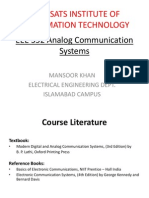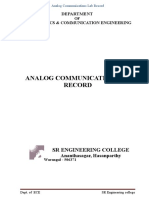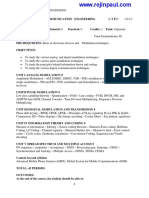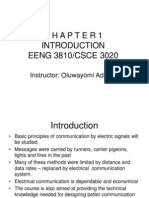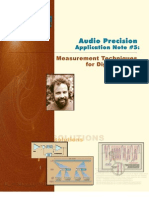ESC Module5 Notes
Uploaded by
swathiswathi7895467ESC Module5 Notes
Uploaded by
swathiswathi7895467Sri Sai Vidya Vikas Shikshana Samithi ®
SAI VIDYA INSTITUTE OF TECHNOLOGY
Approved by AICTE, New Delhi, Affiliated to VTU, Recognized by Govt. of
Karnataka.
Accredited by NBA, New Delhi (CSE, ECE, ISE, MECH & CIVIL), NAAC – “A” Grade
DEPARTMENT OF ELECTRONICS & COMMUNICATION ENGINEERING
RAJANUKUNTE, BENGALURU – 560 064, KARNATAKA
Phone: 080-28468191/96/97/98 * E-mail: hodece@saividya.ac.in * URL www.saividya.ac.in
Course Name: Introduction to Course Code: AY:2022-2023
Electronics Engineering 22ESC143
Course Coordinator: Dr. Chaya B M Scheme: 2022 Batch: 2022
MODULE 5
Syllabus:
Analog Communication Schemes– Modern communication system scheme, Information
source, and input transducer, Transmitter, Channel or Medium – Hardwired and Soft wired,
Noise, Receiver, Multiplexing, Types of communication systems. Types of modulation
(only concepts) – AM , FM, Phase Modulation, Concept of Radio wave propagation (Ground,
space, sky )
Digital Modulation Schemes –Advantages of digital communication over analog
communication , ASK, FSK, PSK, Radio signal transmission ,Multiple access techniques.
Learning Out come :
CO5: Prioritize the need and various types of electronic communication systems, modulation
techniques and multiplexing schemes.
Analog Communication Schemes
MODERN COMMUNICATION SYSTEM SCHEME:
• Communication engineering deals with the techniques of transmitting information.
• Communication engineering means electrical communication, in which information is
transmitted through electrical signals.
• Electrical communication is a process by which the information message is transmitted
from one point to another, from one person to another, or from one place to another in the form
of electrical signals, through some communication link.
• Basic communication system provides a link between the information source and its
destination. The process of electrical communication involves sending, receiving, and
processing information in electrical form.
Dr. Chaya.B.M, Associate Professor, Dept. of ECE SVIT, Bangalore
• The information to be transmitted passes through a number of stages of the
communication system prior it reaches its destination.
• Figure 5.1 shows a block schematic diagram of the most general form of basic
communication system.
Fig 5.1 Schematic diagram of the most general form of basic communication system.
The main constituents of basic communication system are:
(i) Information source and input transducer
(ii) Transmitter
(iii) Channel or medium
(iv) Noise
(v) Receiver
(vi) Output transducer and final destination.
(i) Information source:
• A communication system transmits information from an information source to a
destination and hence the first stage of a communication system is the information source.
• Ex: A sentence or paragraph spoken by a person is a message that contains some
information. The person, in this case, acts as information source. Few other familiar examples
of messages are voice, live scenes, music, written text, and e-mail.
• A communication system transmits information in the form of electrical signal or
signals.
(i) Input transducer:
• A transducer is a device that converts a non-electrical energy into its corresponding
electrical energy called signal and vice versa, e.g., during a telephone conversation, the words
spoken by a person are in the form of sound energy.
• An example of a transducer is a microphone. Microphone converts sound signals into
the corresponding electrical signals.
Dr. Chaya.B.M, Associate Professor, Dept. of ECE SVIT, Bangalore
• Similarly, a television (TV) picture tube converts electrical signals into its
corresponding pictures. Some other examples of transducers are movie cameras, Video
Cassette, Recorder (VCR) heads, tape recorder heads, and loudspeakers.
• The information produced by the information source is applied to the next stage,
termed the information or input /transducer. This in turn, produces an electrical signal
corresponding to the information as output. This electrical signal is called the baseband
signal. It is also called a message signal s(t).
• There are two types of signals. (a) analog signal, and (b) digital signal.
(a) Analog Signal
• An analog signal is a function of time, and has a continuous range of values.
However, there is a definite function value of the analog signal at each point of time.
• A familiar example of analog signal or analog wave form is a pure sine wave form. A
practical example of an analog signal is a voice signal. When a voice signal is converted to
electrical for by a microphone, one gets a corresponding electrical analog signal.
Fig 5.2: Analog signals (a) Pure sine wave (b) Typical speech signal
(b) Digital signal
• A digital signal does not have continuous function values on a time scale. It is discrete
in nature, i.e., it has some values at discrete timings.
• A familiar example of a digital signal is the sound signal produced by drumbeats.
Fig 5.3: Digital signal
Dr. Chaya.B.M, Associate Professor, Dept. of ECE SVIT, Bangalore
• Digital signals in their true sense correspond to a binary digital signal, where the
discrete amplitude of the signal is coded into binary digits represented by ‘0’ and ‘1’.
• The analog signal, which is continuous in time, is converted to discrete time, using a
procedure calling sampling. The continuous amplitude of the analog signal is converted to
discrete amplitude using a process called quantization. Sampling and quantization are
together termed as analog-to-digital conversion (ADC) and the circuitry that performs this
operation is called an analog to-digital converter.
(ii) Transmitter:
The transmitter section processes the signal prior transmission. There are two following
options for processing signals prior transmission:
(i) The baseband signal, which lies in the low frequency spectrum, is translated to a higher
frequency spectrum.
(ii) The baseband signal is transmitted without translating it to a higher frequency spectrum.
• The baseband signal is converted into a corresponding series of sine waves of two
different frequencies prior to transmission. Figure 5.4 illustrates this processing.
• The carrier communication system is based on the principle of translating a low
frequency baseband signal to higher frequency spectrum. This process is termed as
modulation.
• If the baseband signal is a digital signal, the carrier communication system is called a
digital communication system. The digital modulation methods are employed for this.
• If the baseband signal is an analog signal, the carrier communication system is called
as an analog communication system and for processing the analog modulation techniques are
used.
Fig: 5.4 a. The processing of a baseband signal
Dr. Chaya.B.M, Associate Professor, Dept. of ECE SVIT, Bangalore
Block Diagram of Transmitter Section
Fig. 5.5 Block diagram representing schematic of an analog transmitter section
• Figure 5.5 shows the baseband signal, s(t) applied to the modulated stage. This stage
translates the baseband signal from its low frequency spectrum to high frequency spectrum.
This stage also receives another input called the carrier signal, c(t), which is generated by a
high frequency carrier oscillator.
• Modulation takes place at this stage with the baseband and the carrier signals as two
inputs after modulation, the baseband signal is translated to a high frequency spectrum and
the carrier signal is said to be modulated by the baseband signal.
Dr. Chaya.B.M, Associate Professor, Dept. of ECE SVIT, Bangalore
• The output of the modulated stage is called the modulated signal, and is designated as
x(t). The voltage of the modulated signal is then amplified to drive the last stage of the
transmitter, called the power amplifier stage (Fig. 5.5).
• This stage amplifies the power of the modulated signal and thus it carries enough
power to reach the receiver stage of the communication system. Finally, the signal is passed
to the transmission medium or channel.
• Radio signals are transmitted through electromagnetic (em) waves, also referred as
radio waves, in a radio communication system.
• The radio waves have a wide frequency range starting from a few ten kilo Hertz (Hz)
to several thousand Mega Hertz (MHz). This wide range of frequencies is referred as the
radio frequency (RF) spectrum.
(iii) Channel or Medium:
• After the required processing, the transmitter section passes the signal to the
transmission medium.
The signal propagates through the transmission medium and is received at the other side by
the receiver section. The transmission medium between the transmitter and the receiver is
called a channel.
• Channel is a very important part of a communication system as its characteristics add
many constraints to the design of the communication system, e.g., most of the noise is added
to the signal during its transmission through the channel.
• Depending on the physical implementations, one can classify the channels in the
following two groups:
Hardware Channels:
These channels are manmade structure which can be used as transmission medium. There are
following three possible implementations of the hardware channels.
1. Transmission lines
2. Waveguides
3. Optical Fiber Cables (OFC)
• The examples of transmission lines are Twisted-pair cables used in landline telephony
and coaxial cables used for cable TV transmission. However, transmission lines are not
suitable for ultra-high frequency (UHF) transmission.
• To transmit signals at UHF range, Waveguides are employed as medium. Waveguides
are hollow, circular, or rectangular metallic structures. The signals enter the waveguide, are
reflected at the metallic walls, and propagate towards the other end of the waveguide.
Dr. Chaya.B.M, Associate Professor, Dept. of ECE SVIT, Bangalore
• Optical fiber cables are highly sophisticated transmission media, in the form of
extremely thin circular pipes. e.g., landline telephony and cable TV network.
Software Channels:
There are certain natural resources which can be used as the transmission medium for signals.
Such transmission media are called software channels.
• The possible natural resources that can be used as software channels are: air or open
space and sea water.
• The most widely used software channel is air or open space. The signals are
transmitted in the form of electromagnetic (em) waves, also called radio waves.
• Systems that use radio waves to transmit signals through open space are called radio
communication systems, e.g., radio broad cast, television transmission, satellite
communication, and cellular mobile communication.
(iv) Noise:
• In electronics and communication engineering, noise is defined as unwanted electrical
energy of random and unpredictable nature present in the system due to any cause.
Obviously, noise is an electrical disturbance, which does not contain any useful
information. Thus, noise is a highly undesirable part of a communication system, and have to
be minimized.
SNR and Noise Figure (F):
One can define the SNR as the ratio of the signal power to the noise power at a point
in the circuit. Now, if Ps, is signal power and Pn, is noise power, then SNR expressed as S/N,
is given as
𝑆 𝑃𝑠
( )= ( )
𝑁 𝑃𝑛
If Ps = Vs2R and Pn = Vn2R, then
𝑆 𝑃𝑠 𝑉𝑠2 𝑅
= =
𝑅 𝑃𝑛 𝑉𝑛2 𝑅
where Vs, is signal voltage and Vn, is noise voltage.
In addition, it is assumed that both the signal and noise powers are dissipated in the
same resistor R. Therefore, SNR can be expressed in terms of decibels (dB) as
𝑆 𝑉𝑠2
( ) 𝑑𝐵 = 10 log10 ( 2 )
𝑁 𝑉𝑛
𝑆 𝑉𝑠
( ) 𝑑𝐵 = 20 log10 ( )
𝑁 𝑉𝑛
Dr. Chaya.B.M, Associate Professor, Dept. of ECE SVIT, Bangalore
For example, if, at a particular point in a circuit, the signal and noise voltages are given as
3.5 mV and 0.75 mV, respectively, SNR in dB is calculated as:
𝑆 3.5
( ) 𝑑𝐵 = 20 log10 ( )
𝑁 0.75
𝑆
( ) 𝑑𝐵 = 20 log10 (4.66)
𝑁
𝑆
( ) 𝑑𝐵 = 13.38 𝑑𝐵
𝑁
Clearly, the SNR of the circuit at the point is 13.38 dB.
The Noise figure (F) is the measure of the noise introduced by the circuit. It is defined as the
ratio of the signal-to-noise power at the input of the circuit and the signal-to-noise power at the
output of the circuit. Noise figure (r) can be expressed as
𝑆
𝑃𝑜𝑤𝑒𝑟 𝑎𝑡 𝑡ℎ𝑒 𝑖𝑛𝑝𝑢𝑡 𝑡𝑒𝑟𝑚𝑖𝑛𝑎𝑙𝑠 𝑜𝑓𝑡ℎ𝑒 𝑐𝑖𝑟𝑐𝑢𝑖𝑡
𝐹= 𝑁
𝑆
𝑁 𝑃𝑜𝑤𝑒𝑟 𝑎𝑡 𝑡ℎ𝑒 𝑜𝑢𝑡𝑝𝑢𝑡 𝑡𝑒𝑟𝑚𝑖𝑛𝑎𝑙𝑠 𝑜𝑓𝑡ℎ𝑒 𝑐𝑖𝑟𝑐𝑢𝑖𝑡
Receiver:
• The task of the receiver is to provide the original information to the user. This
information is altered due to the processing at the transmitter side.
• The signal received by the receiver, thus does not contain information in its original
form. The receiver system receives the transmitted signal and performs some processing on it
to the original baseband signal.
• The function of the receiver section is to separate the noise from the received signal,
and then recover the original baseband signal by performing some processing on it.
• The receiver performs an operation known as demodulation, which brings the
baseband signal from the higher frequency spectrum to its original low-frequency spectrum.
The demodulation process removes the high frequency carrier from the received signal and
retrieves the original baseband.
Fig: 5.6 Detailed block diagram of a typical receiver section
• From Fig. 5.6 it is evident that the received signal, r(t), is first amplified by the front-
end voltage amplifier. This is done to strengthen the received signal, which is weak and to
Dr. Chaya.B.M, Associate Professor, Dept. of ECE SVIT, Bangalore
facilitate easy processing. Next, this signal is given to the demodulator, which in turn,
demodulates the received signal to recover the original baseband signal. After recovering the
original baseband signal, its voltage and power is amplified prior it to final destination block.
Destination:
Destination is the final stage which is used to convert an electrical message signal into its
original form. For example in radio broadcasting, the destination is a loud speaker which
works as a transducer that converts the electrical signal to original sound signal.
--------------------------------------------------------------------------------------------------------------
MULTIPLEXING
• This is a technique that is most widely used in nearly all types of communication
systems, radio and line communication systems.
• Basically, multiplexing is a process which allows more than one signal to transmit
through a single channel.
• The use of multiplexing also makes the communication system economical because
more than one signal can be transmitted through a single channel.
• Multiplexing is possible in communication system only through modulation.
To consider multiplexing, let us consider the following example. If many people speak loudly
and simultaneously, then it becomes nearly impossible to understand their conversion because
the overall result is noise. This noise is the result of mixing of all the speeches. The human ear
is not capable of separating these intermingled speeches and therefore no intelligent words are
communicated to brain. The same situation is now applied to the transmission of audio signals.
These audio signals may come from, say ten different persons. While the speech frequency of
different persons will be different, all the ten signals will lie in the same audio range of 20 Hz
to 20 kHz.
Dr. Chaya.B.M, Associate Professor, Dept. of ECE SVIT, Bangalore
TYPES OF COMMUNICATION SYSTEMS
One may categorize communication systems based on:
The physical infrastructure pertains to the type of the channel used and the hardware
design of the transmitting and receiving equipment.
The signal specifications signify the nature and type of the transmitted signal
Fig 5.7: Types of Communication Systems
MODULATION
Modulation is the process of changing the parameters of the carrier signal, in accordance with
the instantaneous values of the modulating signal.
TYPES OF MODULATION:
• Amplitude Modulation
• Frequency Modulation
• Phase Modulation
1. Amplitude modulation (AM)
AM is defined as the modulation technique in which the instantaneous amplitude of the
carrier signal is varied in accordance with the instantaneous amplitude of the analog
modulating signal to be transmitted while the frequency and the phase of the carrier signal
remain unchanged.
Figure 5.8 shows the high frequency carrier signal, modulating signal and the modulated
signal.
Dr. Chaya.B.M, Associate Professor, Dept. of ECE SVIT, Bangalore
Fig: 5.8 Waveforms of Amplitude modulation
• It can be clearly seen from the figure 5.8 that the modulating signal seems to be
superimposed on the carrier signal. The amplitude variations in the peak values of the carrier
signal exactly replicate the modulating signal at different points in time which is known as an
envelope.
2. Frequency Modulation(FM):
A modulating signal may vary the frequency of the carrier keeping the amplitude and
phase constant. This type of modulation is called Frequency modulation. Broadly speaking,
the frequency modulation is the process of changing the frequency of the carrier voltage in
accordance with the instantaneous value of the modulating voltage.
The original frequency of the carrier signal is called Centre or resting frequency and
denoted by fc. The amount by which the frequency of the carrier wave changes or shifts
above or below the resting frequency is termed as frequency deviation (Δf). This means Δf ∝
m(t).
The total variation is frequency of F.M. wave from the lowest to the highest is termed
as carrier saving (CS), i.e., US = 2 x frequency deviation in Centre frequency or CS=2 Δf.
Modulation index in F.M. is the ratio of frequency deviation to the modulating
frequency,
i.e. µ𝑓= 𝐹𝑟𝑒𝑞𝑢𝑒𝑛𝑐𝑦 𝐷𝑒𝑣𝑖𝑎𝑡𝑖𝑜𝑛
=
Δ𝑓
𝑀𝑜𝑑𝑢𝑙𝑎𝑡𝑖𝑛𝑔 𝐹𝑟𝑒𝑞𝑢𝑒𝑛𝑐𝑦 𝑓𝑚
Dr. Chaya.B.M, Associate Professor, Dept. of ECE SVIT, Bangalore
Fig: 5.9 Waveforms of Frequency modulation
3. Phase modulation(PM):
• PM is another form of angle modulation. Phase modulation is the process in which the
instantaneous phase of the carrier signal is varied in accordance with the instantaneous
amplitude of the modulating signal.
• In this type of modulation, the amplitude and frequency of the carrier signal remains
unaltered after pulse modulation.
Fig: 5.10 Waveforms of Phase modulation
Dr. Chaya.B.M, Associate Professor, Dept. of ECE SVIT, Bangalore
Radio wave propagation (Ground, space, sky):
• In space communication electromagnetic waves of different frequencies are used to
carry information through the physical space acting as the transmission medium.
Electromagnetic waves with frequencies extending from about 10 kHz to 300 GHz are
classed as radio waves.
• Depending primarily on the frequency a radio wave travels from the transmitting to
the receiving antenna in several ways. On the basis of the mode of propagation, radio waves
can be broadly classified as:
(a) ground or surface wave.
(b) space or tropospheric wave.
(c) sky way.
(a). Ground wave propagation:
• In ground wave propagation, radio waves are guided by the earth and move along its
curved surface from the transmitter to the receiver.
• As the waves moves over the ground, they are strongly influenced by the electrical
properties of the ground. As high frequency waves are strongly absorbed by ground; ground
wave propagation is useful only at low frequencies.
• Below 500 kHz, ground waves can be used for communication within distances of
about 1500 km from the transmitter.
• AM radio broadcast in the medium frequency band cover local areas and take place
primarily by the ground wave. Ground wave transmission is very reliable whatever the
atmospheric conditions be.
(b). Space or tropospheric wave propagation:
• When a radio wave transmitted from an antenna, travelling in a straight line directly
reaches the receiving antenna, it is termed as space or tropospheric wave.
• In space wave or line of sight propagation, radio waves move in the earth's
troposphere within about 15 km over the surface of the earth.
• The space wave is made up of two components:
(a) a direct or line-of- sight MGVE form the transmitting to the receiving antenna.
(b) the ground-reflected urine traversing forms the transmitting antenna to ground and
reflected to the receiving antenna.
• Television frequencies in the range 100-220 MHz are transmitted through this mode.
Dr. Chaya.B.M, Associate Professor, Dept. of ECE SVIT, Bangalore
(c). Sky wave propagation:
• In this mode of propagation, radio waves transmitted from the transmitting antenna
reach the receiving antenna after reflection form the ionosphere, i.e., the ionized layers lying
in the earth's upper atmosphere.
• Short wave transmission around the globe is possible through sky wave via successive
reflections at the ionosphere and the earth's surface.
-----------------------------------------------------------------------------------------------
Digital Modulation Schemes
1. Advantages of digital communication over analog communication
Immunity to Noise (possibility of regenerating the original digital signal if signal
power to noise power ratio (SNR) is relatively high by using of devices called
repeaters along the path of transmission).
Efficient use of communication bandwidth (through use of techniques like
compression).
Digital communication provides higher security (data encryption)
The ability to detect errors and correct them if necessary.
Design and manufacturing of electronics for digital communication systems is much
easier and much cheaper than the design and manufacturing of electronics for analog
communication systems.
• In digital communications, the modulating signal consists of binary data. When it is
required to transmit digital signals on a band pass channel, the amplitude, frequency or phase
of the sinusoidal carrier is varied in accordance with the incoming digital data.
Dr. Chaya.B.M, Associate Professor, Dept. of ECE SVIT, Bangalore
• Since, the digital data is in discrete steps, the modulation of the band pass sinusoidal
carrier is also done in discrete steps. Due to this reason, this type of modulation is known as
digital modulation.
• Digital modulation schemes as classified as under:
• Amplitude Shift Keying (ASK)
• Frequency Shift Keying (FSK)
• Phase Shift Keying (PSK)
Because of constant amplitude of FSK or PSK, the effect of non-linearities, noise interference
is minimum on signal detection. However, these effects are more pronounced on ASK.
Therefore, FSK and PSK are preferred over ASK.
Amplitude Shift Keying(ASK):
ASK represents digital data as variations in the amplitude of a carrier wave
ASK signal can be generated when the incoming binary data and the sinusoidal carrier
are applied to a product modulator as inputs.
Frequency Shift Keying (FSK):
Digital signal is transmitted by switching between low frequency and high
frequency in order to represent 0’s and 1’s.
The simplest FSK is Binary FSK (BFSK).
It uses a pair of discrete frequencies to transmit binary (0s and 1s) information.
Dr. Chaya.B.M, Associate Professor, Dept. of ECE SVIT, Bangalore
Phase Shift Keying (PSK):
. The carrier Phase is shifted between two different phases (typically 00 to 1800 )
depending on whether 0-bit or 1-bit is being transmitted.
The simplest form of PSK is Binary Phase Shift Keying (BPSK).
Radio Signal Transmission
Fig 5.14 shows the architecture of a wireless communication transmitter. In the figure,
the transmitter usually processes the information in two stages. In the first stage, a
modulator accepts the incoming bits, and computes symbols that represent the
amplitude and phase of the outgoing wave. It then passes these to the analogue
transmitter, which generates the radio wave itself.
The modulation scheme used in Fig. 5.14 is known as quadrature phase shift keying
(QPSK).
A QPSK modulator takes the incoming bits two at a time and transmits them using a
radio wave that can have four different states. These have phases of 45°, 135°, 225° and
315°.
Fig 5.14: Architecture of a wireless communication transmitter
Dr. Chaya.B.M, Associate Professor, Dept. of ECE SVIT, Bangalore
5.15: Quadrature phase shift keying (a) Example QPSK waveform (b) QPSK constellation
diagram
Fig. 5.15 (a), which correspond to bit combinations of 00, 10, 11 and 01 respectively.
We can represent the four states of QPSK using the constellation diagram shown in Fig.
5.15 (b).
In this diagram, the distance of each state from the origin represents the amplitude of the
transmitted wave, while the angle (measured anti-clockwise from the x-axis) represents its
phase. Usually, it is more convenient to represent each symbol using two other numbers, which
are known as the in-phase (I) and quadrature (Q) components. These are computed as follows:
I = a cos ɸ
Q = a sin ɸ
where a is the amplitude of the transmitted wave and ɸ is its phase.
Mathematicians will recognize the in-phase and quadrature components as the real and
imaginary parts of a complex number.
As shown in Fig. 5.16, LTE uses four modulation schemes altogether. Binary phase shift
keying (BPSK) sends bits one at a time, using two states that can be interpreted as starting
phases of 0° and 180°, or as signal amplitudes of +1 and -1.
LTE uses this scheme for a limited number of control streams, but does not use it for normal
data transmissions.
16 quadrature amplitude modulation (16-QAM) sends bits four at a time, using 16 states that
have different amplitudes and phases.
Similarly, 64-QAM sends bits six at a time using 64 different states, so it has a data rate six
times greater than that of BPSK.
Dr. Chaya.B.M, Associate Professor, Dept. of ECE SVIT, Bangalore
Fig 5.16: Modulation schemes used by LTE
Multiple Access Techniques:
The techniques described so far work well for one-to-one communications. In a cellular
network, however, a base station has to transmit to many different mobiles at once. It does
this by sharing the resources of the air interface, in a technique known as multiple access.
Mobile communication systems use a new different multiple access technique, two of which
are shown in Fig. 4.17 frequency division multiple access (FDMA) was used by the first-
generation analogue systems. In this technique, each mobile receives information on its own
carrier frequency, which it distinguishes from the others by the use of analogue filters.
In time division multiple access (TDMA), mobiles receive information on the same carrier
frequency but at different times.
GSM uses a mix of frequency and time division multiple access, in which every cell has
several carrier frequencies that are each shared amongst eight different mobiles.
LTE uses another mixed technique known as orthogonal frequency division multiple access
(OFDMA).
Fig 5.17: Example multiple access techniques
Third generation communication systems used a different technique altogether, known as
code division multiple access (CDMA).
Dr. Chaya.B.M, Associate Professor, Dept. of ECE SVIT, Bangalore
In this technique, mobiles receive on the same carrier frequency and at the same time, but
the signals are labelled by the use of codes, which allow a mobile to separate its own signal
from those of the others.
LTE uses a few of the concepts from CDMA for some of its control signals, but does not
implement the technique otherwise. Multiple access is actually a generalization of a simpler
technique known as multiplexing.
Dr. Chaya.B.M, Associate Professor, Dept. of ECE SVIT, Bangalore
You might also like
- Introduction To Electronics and Communication (BESCK104C/BESCK204C) - Analog and Digital Communication (Module 5)75% (4)Introduction To Electronics and Communication (BESCK104C/BESCK204C) - Analog and Digital Communication (Module 5)106 pages
- Basic Electronics and Communication Engineering (21ELN14/21ELN24) - Analog and Digital Communication (Module 4)100% (1)Basic Electronics and Communication Engineering (21ELN14/21ELN24) - Analog and Digital Communication (Module 4)154 pages
- New Appendix 1 Non Revenue Water and Large Water Meter Calibration. Johnson E 6 May 2016100% (1)New Appendix 1 Non Revenue Water and Large Water Meter Calibration. Johnson E 6 May 201611 pages
- Module 4 Basic Electronics Notes 2021pdfNo ratings yetModule 4 Basic Electronics Notes 2021pdf33 pages
- Introduction To Electronics Engineering 22ESC143100% (1)Introduction To Electronics Engineering 22ESC14321 pages
- Comsats Institute of Information Technology: EEE 352 Analog Communication SystemsNo ratings yetComsats Institute of Information Technology: EEE 352 Analog Communication Systems44 pages
- Comsats Institute of Information Technology: EEE 352 Analog Communication SystemsNo ratings yetComsats Institute of Information Technology: EEE 352 Analog Communication Systems35 pages
- Unit Vi - Communication Systems: Elements of Communication SystemNo ratings yetUnit Vi - Communication Systems: Elements of Communication System18 pages
- Introduction To Electronics Mod 5 Updated 1No ratings yetIntroduction To Electronics Mod 5 Updated 118 pages
- 1 A) Draw The Basic Block Diagram of Communication SystemNo ratings yet1 A) Draw The Basic Block Diagram of Communication System29 pages
- Communication Systems (EE-341) : Lecture-2 Introduction Part-2No ratings yetCommunication Systems (EE-341) : Lecture-2 Introduction Part-234 pages
- The 8051 Microcontroller Based Embedded Systems50% (8)The 8051 Microcontroller Based Embedded Systems45 pages
- Chapter 5 - Data Acquisition Systems May 21 PMRNo ratings yetChapter 5 - Data Acquisition Systems May 21 PMR51 pages
- 48VCD-1 - 48V Telecom Battery Monitor (Rev A-101) PDFNo ratings yet48VCD-1 - 48V Telecom Battery Monitor (Rev A-101) PDF13 pages
- Control Practices Using Simulink With Arduino As Low Cost HardwareNo ratings yetControl Practices Using Simulink With Arduino As Low Cost Hardware6 pages
- Implementation of The LMS Algorithm For Noise CancNo ratings yetImplementation of The LMS Algorithm For Noise Canc69 pages
- USER_GUIDE_Kaizen_Relay_Control_Module_GUINo ratings yetUSER_GUIDE_Kaizen_Relay_Control_Module_GUI17 pages
- User's Manual: Model CA51, CA71 Handy Cal (Calibrator)No ratings yetUser's Manual: Model CA51, CA71 Handy Cal (Calibrator)111 pages
- Bangladesh University of Professionals: Department of Information and Communication TechnologyNo ratings yetBangladesh University of Professionals: Department of Information and Communication Technology5 pages
- Digital Communications: Lab Manual (Student Copy)No ratings yetDigital Communications: Lab Manual (Student Copy)78 pages
- Emulation of Analog Controllers: 2.1: Control Design Via Time-Domain EmulationNo ratings yetEmulation of Analog Controllers: 2.1: Control Design Via Time-Domain Emulation47 pages
- ESPD GPIO A-D and Comparator On Arduino UNO BoardNo ratings yetESPD GPIO A-D and Comparator On Arduino UNO Board26 pages
- BSS138LT1 Power MOSFET 200 Ma, 50 V: N Channel SOT 23No ratings yetBSS138LT1 Power MOSFET 200 Ma, 50 V: N Channel SOT 237 pages
- An-5 Measurement Techniques For Digital Audio by Julian DunnNo ratings yetAn-5 Measurement Techniques For Digital Audio by Julian Dunn203 pages
- Introduction To Electronics and Communication (BESCK104C/BESCK204C) - Analog and Digital Communication (Module 5)Introduction To Electronics and Communication (BESCK104C/BESCK204C) - Analog and Digital Communication (Module 5)
- Basic Electronics and Communication Engineering (21ELN14/21ELN24) - Analog and Digital Communication (Module 4)Basic Electronics and Communication Engineering (21ELN14/21ELN24) - Analog and Digital Communication (Module 4)
- New Appendix 1 Non Revenue Water and Large Water Meter Calibration. Johnson E 6 May 2016New Appendix 1 Non Revenue Water and Large Water Meter Calibration. Johnson E 6 May 2016
- Comsats Institute of Information Technology: EEE 352 Analog Communication SystemsComsats Institute of Information Technology: EEE 352 Analog Communication Systems
- Comsats Institute of Information Technology: EEE 352 Analog Communication SystemsComsats Institute of Information Technology: EEE 352 Analog Communication Systems
- Unit Vi - Communication Systems: Elements of Communication SystemUnit Vi - Communication Systems: Elements of Communication System
- 1 A) Draw The Basic Block Diagram of Communication System1 A) Draw The Basic Block Diagram of Communication System
- Communication Systems (EE-341) : Lecture-2 Introduction Part-2Communication Systems (EE-341) : Lecture-2 Introduction Part-2
- Learn Amateur Radio Electronics on Your SmartphoneFrom EverandLearn Amateur Radio Electronics on Your Smartphone
- 48VCD-1 - 48V Telecom Battery Monitor (Rev A-101) PDF48VCD-1 - 48V Telecom Battery Monitor (Rev A-101) PDF
- Control Practices Using Simulink With Arduino As Low Cost HardwareControl Practices Using Simulink With Arduino As Low Cost Hardware
- Implementation of The LMS Algorithm For Noise CancImplementation of The LMS Algorithm For Noise Canc
- User's Manual: Model CA51, CA71 Handy Cal (Calibrator)User's Manual: Model CA51, CA71 Handy Cal (Calibrator)
- Bangladesh University of Professionals: Department of Information and Communication TechnologyBangladesh University of Professionals: Department of Information and Communication Technology
- Emulation of Analog Controllers: 2.1: Control Design Via Time-Domain EmulationEmulation of Analog Controllers: 2.1: Control Design Via Time-Domain Emulation
- BSS138LT1 Power MOSFET 200 Ma, 50 V: N Channel SOT 23BSS138LT1 Power MOSFET 200 Ma, 50 V: N Channel SOT 23
- An-5 Measurement Techniques For Digital Audio by Julian DunnAn-5 Measurement Techniques For Digital Audio by Julian Dunn










